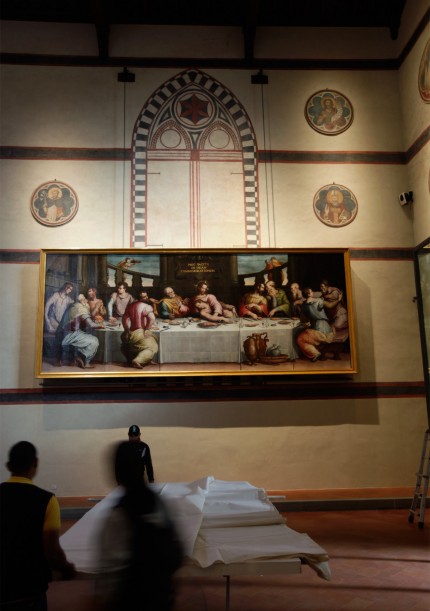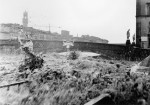 It’s been exactly 50 years since the Arno river in Florence broke its banks and flooded the historic city with 22 feet of toxic sludge. Some of the greatest art in the world, 14,000 artworks and books, were lost forever. Many thousands more pieces of Florence’s immense cultural patrimony spent a day soaked in a dangerous, volatile and destructive mixture of water, mud, gas, sewage and naphtha forced out of underground home fuel tanks by the 40-mile-an-hour floodwaters.
It’s been exactly 50 years since the Arno river in Florence broke its banks and flooded the historic city with 22 feet of toxic sludge. Some of the greatest art in the world, 14,000 artworks and books, were lost forever. Many thousands more pieces of Florence’s immense cultural patrimony spent a day soaked in a dangerous, volatile and destructive mixture of water, mud, gas, sewage and naphtha forced out of underground home fuel tanks by the 40-mile-an-hour floodwaters.
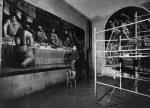 One of the worst hit was the monumental 21-by-8-feet panel painting The Last Supper made in 1546 by painter and art historian Giorgio Vasari. Kept in the Basilica of Santa Croce which is a few blocks from the Arno and at a lower elevation than much of the rest of the city, The Last Supper was completely submerged in filth for more than 12 hours. When the waters receded, they literally pulled the paint and gesso underlay off the five poplar panels which were now the consistency of a sponge.
One of the worst hit was the monumental 21-by-8-feet panel painting The Last Supper made in 1546 by painter and art historian Giorgio Vasari. Kept in the Basilica of Santa Croce which is a few blocks from the Arno and at a lower elevation than much of the rest of the city, The Last Supper was completely submerged in filth for more than 12 hours. When the waters receded, they literally pulled the paint and gesso underlay off the five poplar panels which were now the consistency of a sponge.
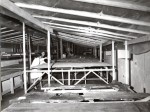 The Mud Angels, volunteers who flocked to Florence to do everything they could to save its mortally wounded art, waded through the sludge scooping up any tiny fragment of paint they could find. Art conservator Marco Grassi, carpenter Ciro Castelli and others worked together to salvage the moribund panel paining. They affixed sheets of Japanese mulberry paper to the surface with methacrylate resin to keep the blistered and peeling paint from coming off. The painting was then taken apart and its five component panels laid out flat on racks in the conservatory of a lemon orchard. The relatively humid environment, it was hoped, would allow the panels to dry slowly and minimize cracking and warping. It was the best they could do at the time, but the panels dried hard anyway. They lost two centimeters in width and developed cracks. The gesso primer dried poorly too, becoming unstable and crumbly.
The Mud Angels, volunteers who flocked to Florence to do everything they could to save its mortally wounded art, waded through the sludge scooping up any tiny fragment of paint they could find. Art conservator Marco Grassi, carpenter Ciro Castelli and others worked together to salvage the moribund panel paining. They affixed sheets of Japanese mulberry paper to the surface with methacrylate resin to keep the blistered and peeling paint from coming off. The painting was then taken apart and its five component panels laid out flat on racks in the conservatory of a lemon orchard. The relatively humid environment, it was hoped, would allow the panels to dry slowly and minimize cracking and warping. It was the best they could do at the time, but the panels dried hard anyway. They lost two centimeters in width and developed cracks. The gesso primer dried poorly too, becoming unstable and crumbly.
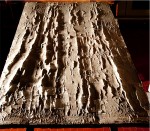 The technology to repair the overwhelming amount of damage simply did not exist in 1966. It wouldn’t exist for another 40+ years. The breakthrough happened in 2010, when the Getty Foundation gave a $400,000 grant to the Opificio delle Pietre Dure, the stone mosaic workshop founded in the 16th century which has become one of the world’s leading art restoration institutes, to bring The Last Supper back from the dead and enlist the great expertise and experience of retired or retiring panel-painting conservators to train a new generation.
The technology to repair the overwhelming amount of damage simply did not exist in 1966. It wouldn’t exist for another 40+ years. The breakthrough happened in 2010, when the Getty Foundation gave a $400,000 grant to the Opificio delle Pietre Dure, the stone mosaic workshop founded in the 16th century which has become one of the world’s leading art restoration institutes, to bring The Last Supper back from the dead and enlist the great expertise and experience of retired or retiring panel-painting conservators to train a new generation.
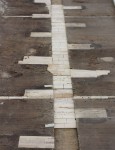 It was backbreaking labour. Removing the mulberry paper proved a devilish task, with swaths of paint, detached from the brittle gesso layer, coming off with the paper. Fixing the panels themselves was an immense challenge as well. They had to be enlarged to their original size in order to put the curled and lifted paint back into place. Ciro Castelli devised an ingenious method to resolve that conundrum. He cut tiny slits in the back and filled them and the original dowel tracks with jigsaw puzzles of poplar wood filler. This precision system stretched the panels and will also help preserve them going forward since it gives them room to expand and contract naturally.
It was backbreaking labour. Removing the mulberry paper proved a devilish task, with swaths of paint, detached from the brittle gesso layer, coming off with the paper. Fixing the panels themselves was an immense challenge as well. They had to be enlarged to their original size in order to put the curled and lifted paint back into place. Ciro Castelli devised an ingenious method to resolve that conundrum. He cut tiny slits in the back and filled them and the original dowel tracks with jigsaw puzzles of poplar wood filler. This precision system stretched the panels and will also help preserve them going forward since it gives them room to expand and contract naturally.
 In 2013, the five panels were put back together for the first time since 1966. In 2014, fashion house Prada donated a big chunk of change for the last phase of restoration. With this extra boost, restorers hoped they’d be able to complete their work in time for the 50th anniversary of the flood and they succeeded. On November 4th, 2016, Giorgio Vasari’s The Last Supper went back on display at the Museo dell’Opera in the old refectory of Santa Croce.
In 2013, the five panels were put back together for the first time since 1966. In 2014, fashion house Prada donated a big chunk of change for the last phase of restoration. With this extra boost, restorers hoped they’d be able to complete their work in time for the 50th anniversary of the flood and they succeeded. On November 4th, 2016, Giorgio Vasari’s The Last Supper went back on display at the Museo dell’Opera in the old refectory of Santa Croce.
 There’s a wonderful article on the flood and restoration of the Vasari painting in The New York Times by Paula Deitz, who was in Florence on the day of the flood November 4th, 1966, in which Marco Grassi talks about his how they worked to save The Last Supper.
There’s a wonderful article on the flood and restoration of the Vasari painting in The New York Times by Paula Deitz, who was in Florence on the day of the flood November 4th, 1966, in which Marco Grassi talks about his how they worked to save The Last Supper.
